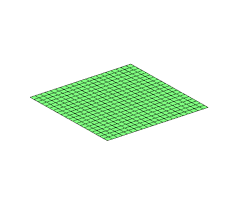
A | B | C | D | E | F | G | H | CH | I | J | K | L | M | N | O | P | Q | R | S | T | U | V | W | X | Y | Z | 0 | 1 | 2 | 3 | 4 | 5 | 6 | 7 | 8 | 9
The wave equation is a second-order linear partial differential equation for the description of waves or standing wave fields such as mechanical waves (e.g. water waves, sound waves and seismic waves) or electromagnetic waves (including light waves). It arises in fields like acoustics, electromagnetism, and fluid dynamics.
This article focuses on two-way waves in classical physics. Single mechanical or electromagnetic waves propagating in a pre-defined direction can also be described with the first-order one-way wave equation, which is much easier to solve and also valid for inhomogeneous media. Quantum physics uses an operator-based wave equation often as a relativistic wave equation.
Introduction
The (two-way) wave equation is a hyperbolic partial differential equation describing waves, including traveling and standing waves; the latter can be considered as linear superpositions of waves traveling in opposite directions. This article mostly focuses on the scalar wave equation describing waves in scalars by scalar functions u = u (x, y, z, t) of a time variable t (a variable representing time) and one or more spatial variables x, y, z (variables representing a position in a space under discussion). At the same time, there are vector wave equations describing waves in vectors such as waves for an electrical field, magnetic field, and magnetic vector potential and elastic waves. By comparison with vector wave equations, the scalar wave equation can be seen as a special case of the vector wave equations; in the Cartesian coordinate system, the scalar wave equation is the equation to be satisfied by each component (for each coordinate axis, such as the x component for the x axis) of a vector wave without sources of waves in the considered domain (i.e., space and time). For example, in the Cartesian coordinate system, for as the representation of an electric vector field wave in the absence of wave sources, each coordinate axis component (i = x, y, z) must satisfy the scalar wave equation. Other scalar wave equation solutions u are for physical quantities in scalars such as pressure in a liquid or gas, or the displacement along some specific direction of particles of a vibrating solid away from their resting (equilibrium) positions.
The scalar wave equation is
An explanation of the terms and notation:
- c is a fixed non-negative real coefficient.
- u: scalar field representing a displacement from rest situation – it could be gas pressure above or below normal, or the height of water in a pond above or below rest, or another variable such as potential.
- x, y and z: represents each of the dimensions of space or position.
- t: represents time.
- : measures how forcefully the displacement is being changed.
- : measures how the displacement is varying at the point x in the x dimension. It is not the rate at which the displacement is changing across space but, in fact, the rate at which the change itself is changing across space – its second derivative. In other words, this term shows how the displacement's changes are squashed up near x.
- and are for the other dimensions, like the term with x above.
The equation states that at any given instance, at any given point, the acceleration of the displacement is proportional to the way the displacement's changes are squashed up in the surrounding area. In other words, a more pointy displacement gets pushed back more forcefully.
Using the notations of Newtonian mechanics and vector calculus, the wave equation can be written compactly as
where the double dot on denotes two time derivatives of u, ∇ is the nabla operator, and ∇2 = ∇ · ∇ is the (spatial) Laplacian operator (not vector Laplacian):
Antropológia
Aplikované vedy
Bibliometria
Dejiny vedy
Encyklopédie
Filozofia vedy
Forenzné vedy
Humanitné vedy
Knižničná veda
Kryogenika
Kryptológia
Kulturológia
Literárna veda
Medzidisciplinárne oblasti
Metódy kvantitatívnej analýzy
Metavedy
Metodika
Text je dostupný za podmienok Creative
Commons Attribution/Share-Alike License 3.0 Unported; prípadne za ďalších
podmienok.
Podrobnejšie informácie nájdete na stránke Podmienky
použitia.
www.astronomia.sk | www.biologia.sk | www.botanika.sk | www.dejiny.sk | www.economy.sk | www.elektrotechnika.sk | www.estetika.sk | www.farmakologia.sk | www.filozofia.sk | Fyzika | www.futurologia.sk | www.genetika.sk | www.chemia.sk | www.lingvistika.sk | www.politologia.sk | www.psychologia.sk | www.sexuologia.sk | www.sociologia.sk | www.veda.sk I www.zoologia.sk













